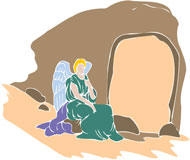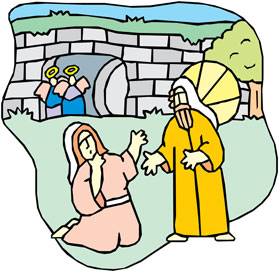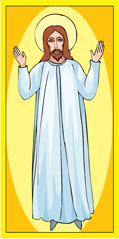

Editor's note: When first
published
in the Does God
Exist? bulletin this article covered two issues:
January/February 2011 and March/April 2011. With this online edition of
this article the two parts were recombined as the author originally
wrote it. The endnotes and the bibliography are at the end of
this online article, unlike in the printed versions.
From the very beginning of Christianity
the message has been that Jesus
died, was buried, and was raised from the dead. In the first recorded
sermon, Peter boldly proclaimed regarding Jesus: “This man was handed
over to you by God’s set purpose and foreknowledge; and you, with the
help of wicked men, put him to death by nailing him to the cross. But
God raised him from the dead, freeing him from the agony of death,
 because it was impossible for death to keep its hold on
him. … God has
raised this Jesus to life, and we are all witnesses of the fact” (Acts
2:23 – 24, 32). 1
because it was impossible for death to keep its hold on
him. … God has
raised this Jesus to life, and we are all witnesses of the fact” (Acts
2:23 – 24, 32). 1
The “fact” to which Peter referred was
nothing less than the conquering of death, the enemy of mankind since
the beginning. This message — that there is life beyond the
grave — quickly became the central theme of the preaching of the
disciples of Jesus and the foundation of the Christian faith.
The resurrection from the dead is a common
theme in the New Testament. The concept of the resurrection and life
after death, however, had its beginnings in the Old Testament. In this
issue we are going to briefly examine the resurrection in the Old
Testament.
THE RESURRECTION IN THE OLD TESTAMENT
The Hebrew religion tended to place
emphasis primarily on the present life. Blessings or punishment, for
individuals or the nation of Israel, were seen as occurring at either
the present time, or if in the future, through descendants. That is not
to say, however, that there was no concept of an afterlife among the
Hebrew people. There are passages in the Old Testament that many
believe teach that life exists beyond the grave. Unlike the New
Testament, however, there is no clearly defined doctrine of the
resurrection in the Old Testament. The passages in the Old Testament
provide at best a glimpse into the afterlife but nothing to compare
with the hope expressed in the New Testament.
 The development of the concept of
the
resurrection in the Old Testament begins perhaps as early as the Garden
of Eden with the promise that came with the curse resulting from the
first sin (Genesis 3:15). Over time
the concept became more developed
through further revelation especially in the books of the Wisdom
Literature and the Prophets. Later in the Old Testament period the
concept of the resurrection became more fully developed among the
Hebrew people. This can be seen, for example, in the fact that Jesus
condemned the Sadducees for their denial of the resurrection (Matthew
22:32; Mark 12:27; Luke 20:38). Thus, by the time of Jesus there
was
some expectation of existence after death among the Jewish people.
The development of the concept of
the
resurrection in the Old Testament begins perhaps as early as the Garden
of Eden with the promise that came with the curse resulting from the
first sin (Genesis 3:15). Over time
the concept became more developed
through further revelation especially in the books of the Wisdom
Literature and the Prophets. Later in the Old Testament period the
concept of the resurrection became more fully developed among the
Hebrew people. This can be seen, for example, in the fact that Jesus
condemned the Sadducees for their denial of the resurrection (Matthew
22:32; Mark 12:27; Luke 20:38). Thus, by the time of Jesus there
was
some expectation of existence after death among the Jewish people.
Before looking at specific passages
related to the concept of the resurrection it is necessary to first
examine the concept of death as found in the Old Testament. The Old
Testament concept of human beings consisted of a physical body made of
flesh (basar), a spirit (ruah), and a soul (nephesh). Death, in Hebrew
thought involved all three of these entities. The physical body is made
of dust and returns to the dust after death (Genesis 2:7; 3:19). It was
also believed that at death the spirit (or breath) is withdrawn (Psalm
104:29; Ecclesiastes 12:7), and the soul (nephesh) was sent to sheol or
the place of the dead (Psalm 16:10).
Thus, in the Old Testament death is viewed
as the end of physical life but not the termination of existence. The
dead, though separated from this life, continued to exist.
Sheol represented a dark and unknown
existence, but there was still some hope in the minds of the Hebrew
people. David, for example, wrote in reference to God in Psalm 139:8:
“If I make my bed in the depths (sheol) you are there.”
There are several examples in the Old
Testament of God miraculously intervening in the natural processes of
death. Although these are not directly related to the resurrection,
they are important in understanding existence after death. These events
related to death or the afterlife fall into three categories. The first
of these events involved the raising of certain individuals from the
dead. These include (1) the son of the widow of Zerephath (1 Kings
17:17 – 24), (2) the son of the Shunammite woman (2 Kings 4:18 – 37),
and (3) a man thrown into Elisha’s grave (2 Kings 13:20 – 21). In
miracles such as these, known as revitalization or resuscitation, a
person was returned to his or her previous life. Apparently, however,
these individuals eventually died again.
The second of these events occurred when
Enoch (Genesis 5:24; cf. Hebrews 11:5) and
Elijah (2 Kings 2:10 –11)
were taken by God from this life into another realm. The details are
few, but it appears that Enoch and Elijah passed from this life into
the next without experiencing death, as we know it.
The third event was the strange account of
the “witch” of Endor calling Samuel from the grave (1 Samuel
28:3 – 25). Although this has little to do with the concept of the
resurrection, bringing Samuel back from the dead would, like the
previous examples, at least confirm that death is not annihilation and
that individuals continue to exist after death.
In addition to these historical events
there are also several Old Testament passages that refer either
directly or indirectly to the raising of the dead or life after death.
It is recorded, for example, that Hannah said in her prayer, “The LORD
brings death and makes alive; he brings down to the grave and raises
up” (1 Samuel 2:6). Although the
language is not very specific, this
passage would at least suggest that God could raise the dead and
deliver a person from sheol.
In another passage, Job speaks of seeing
God after death: “And after my skin has been destroyed, yet will I see
God; I myself will see him with my own eyes — I, and not another. How
my heart yearns within me!” (Job
19:25 – 27). Not all scholars agree
that this is a reference to the resurrection. It would seem, however,
that the statement reflects at least a belief in an existence after
death or even an actual reference to the resurrection.
There are several passages in the Psalms
that give additional insight into life after death. One example is
found in Psalm 16:9 –11,
especially in verse 10, which reads: “because
you will not abandon me to the grave [sheol], nor will you let your
Holy One see decay.” This verse is especially significant in light of
the fact that it was quoted by Peter in Acts
2:25 – 28 in reference to
the resurrection of Jesus. Another is found in Psalm 49:15, which
reads: “But God will redeem my life from the grave; he will surely take
me to himself.” (See also Psalms
17:15
and
73:23
– 26.)
 The clearest expressions in the
Old
Testament of belief in life after death and resurrection of the dead
are found in the prophets. 2 In Isaiah 25:8, for
example, Isaiah prophesied that God “will swallow up death forever.”
Another example is in Isaiah 26:19, which reads: “But your dead will
live; their bodies will rise. You who dwell in the dust, wake up and
shout for joy. Your dew is like the dew of the morning; the earth will
give birth to her dead.” Some scholars interpret these prophecies in
reference to restoring the people of Israel as a nation, while others,
see these passages as clear references to a resurrection of the dead.
The clearest expressions in the
Old
Testament of belief in life after death and resurrection of the dead
are found in the prophets. 2 In Isaiah 25:8, for
example, Isaiah prophesied that God “will swallow up death forever.”
Another example is in Isaiah 26:19, which reads: “But your dead will
live; their bodies will rise. You who dwell in the dust, wake up and
shout for joy. Your dew is like the dew of the morning; the earth will
give birth to her dead.” Some scholars interpret these prophecies in
reference to restoring the people of Israel as a nation, while others,
see these passages as clear references to a resurrection of the dead.
Isaiah
53:10 – 12 is another prophecy that
is often seen as relevant to the concept of the resurrection. As a part
of the Suffering Servant passages in Isaiah, this is especially
applicable to the resurrection of Jesus.
The prophecy of Ezekiel concerning the dry
bones coming to life certainly uses language that is suggestive of a
resurrection of the dead (Ezekiel
37:1 –14). This passage is usually
interpreted, however, as a reference to the future raising up and
restoring of the nation rather than individuals. Many scholars also
interpret the prophecy in Hosea 6:1– 3
as referring to the restoration
of the people of Israel even though Hosea also used language suggestive
of a bodily resurrection.
The Old Testament passage which is most
commonly interpreted to be a reference to the resurrection of the dead
is Daniel 12:2 which reads:
“Multitudes who sleep in the dust of the
earth will awake: some to everlasting life, others to shame and
everlasting contempt.” Even this prophecy by Daniel is lacking in
specific details. Like some of the other Old Testament passages
examined here, however, it does point to a future time when the dead
will be raised.
Thus, even though the Jewish people had a
limited understanding of death and future life, they were not left
without a future hope. And that hope, was to be manifested in the
person of Jesus Christ, as he alone was able to conquer that enemy of
mankind — death itself.
The hope of a future resurrection in
Jewish thinking became more developed during the intertestamental
period and was common at the time of Jesus ministry. That does not
necessarily mean that there was uniform agreement, however. The
Pharisees, for example, were known for their belief in a physical,
bodily resurrection, while the Sadducees did not believe in a
resurrection of the dead.
Of those Jewish people who did believe in
a resurrection of the dead, the most common view was that the righteous
would he raised from the dead on the last day. This can be seen for
example in Martha’s reply to Jesus when he told her that her brother
would rise from the dead. She said to Jesus, “I know he will rise again
in the resurrection at the last day” (John 11:24).
THE
RESURRECTION
IN
THE
GOSPELS
The raising of the dead was a part of the
ministry of Jesus as it is recorded in the Gospels. For example, when
questioned by the disciples of John if he was “the one who was to
come,” Jesus’ reply included a list of miraculous healings along with
the statement that “the dead are raised” (Matthew
11:5;
Luke
7:22).
Also, when Jesus sent out the twelve disciples he gave them
instructions to not only heal the sick, but to “raise the dead’
(Matthew 10:8).
The Gospels also contain four specific
examples of individuals that were raised from the dead. These include
the son of a widow of Nain (Luke
7:11
–17), daughter of Jairus (Matthew
9:18
–19, 23 – 26; Mark: 5:21 – 24, 35 – 43; Luke 8:40 – 42, 49 – 56),
Lazarus (John 11:1 – 44),
and people who were raised at the time of
Jesus’ crucifixion and resurrection (Matthew
27:52
– 53).
The widow’s son and Jairus’ daughter were
similar events and reminiscent of the raising of the dead by Elijah and
Elisha in the Old Testament. Both individuals had been dead only a
relatively short time, and thus more correctly were examples of
revitalization or resuscitation. Physical life was restored to the dead
bodies and the individuals continued to live for a time in the same
bodily form that they had before death.
The raising of Lazarus, however, was
different from the others. Lazarus had been dead for four days and the
processes of decomposition would have been well underway. There was a
Jewish tradition at the time that after death the soul remained near
the body for three days in case the person might somehow be
resuscitated. Lazarus had been dead for four days and thus beyond even
this distant hope. Thus, the raising of Lazarus was obviously intended
to demonstrate God’s power over death that was manifested in Jesus.
 The final example of people
raised from
the dead in the Gospels is the brief account in Matthew of several
people emerging from their graves at the time of Jesus’ crucifixion, or
more correctly, his resurrection. Jewish beliefs would have anticipated
an event such as this to occur at the coming of the Messiah. Nothing is
known, however, outside of Matthew’s account and the event remains
obscure.
The final example of people
raised from
the dead in the Gospels is the brief account in Matthew of several
people emerging from their graves at the time of Jesus’ crucifixion, or
more correctly, his resurrection. Jewish beliefs would have anticipated
an event such as this to occur at the coming of the Messiah. Nothing is
known, however, outside of Matthew’s account and the event remains
obscure.
The Gospels also contain several examples
of Jesus’ teaching on the resurrection and life after death. Jesus’
discussion with the Sadducees on the nature of the resurrection is one
such example (Mark 12:18 – 27;
Matthew 22:23 – 33; Luke 20:27 – 40).
The Sadducees, as noted earlier, did not believe in the resurrection of
the dead. Many of those Jewish people who did believe in the
resurrection, assumed that those who experienced the resurrection would
resume their earthly life and relationships. This was the point of the
exaggerated story of the woman and her various husbands presented by
the Sadducees. Jesus, however, took a different view. As he put it,
“When the dead rise, they will neither marry nor be given in marriage;
they will be like angels in heaven” (Mark 12:25). This
should not be
misunderstood to suggest that the resurrected person will be some sort
of spirit without a body. Rather, it seems that Jesus is teaching that
after the resurrection, physical relationships, such as marriage, will
no longer exist.
Jesus also at times taught on the general
subject of eternal life. One example occurred when a man came to Jesus
asking, “What must I do to inherit eternal life?” (Mark 10:17 – 31;
Matthew 19:16 – 30; Luke 18:18 – 30). In the discussion that
followed
this incident, Jesus indicated that eternal life is to be in “the age
to come” (Mark 10:30), thus
affirming that there will be life after
death
In the Gospel of John there are several
occasions in which Jesus spoke of raising the dead. One example is
found in John 5:21 where Jesus said
“For just as the Father raises the
dead and gives them life, even so the Son gives life to whom he is
pleased to give it.” Jesus continued this thought further by stating
that “a time is coming when all who are in their graves will hear his
[Son of Man’s] voice and come out — those who have done good will rise
to live, and those who have done evil will rise to be condemned” (John
5:28 – 29). Jesus clearly teaches here the future raising of the
dead
in a manner suggestive of`Daniel’s prophecy (Daniel 12:2 – 3). He also
asserts that he, himself has been given authority to accomplish this.
Perhaps the most explicit teaching on the
resurrection is found within the context of the raising of Lazarus
(John 11:1 – 44). Speaking to
Martha, Jesus said, “Your brother will
rise again” (verse 23).
Following Martha’s reply expressing the Jewish
belief in a final resurrection, Jesus said, “I am the resurrection and
the life. He who believes in me will live, even though he dies; and
whoever lives and believes in me will never die” (verses 25 – 26).
Thus, Jesus clearly stated that even though one who believes in him may
experience physical death, that person can anticipate being raised to a
life that knows no death. As Jesus expressed it, “whoever lives and
believes in me will never die.”
In addition to Jesus’ teaching on the
resurrection, the Gospels also contain several examples of predictions,
or prophecies, made by Jesus concerning his own resurrection. The more
well known of these are found in Mark
8:31,
9:31,
and
10:33 – 34 and
the parallels in Matthew and Luke.
 In these passages
Jesus clearly predicted
that he would die and be raised again on the third day. Because he
predicted specific events, some have questioned the authenticity of
these statements. It is assumed here, however, that Jesus did in fact
make these statements prior to his death and that he was predicting
that he would be bodily raised from the dead.
In these passages
Jesus clearly predicted
that he would die and be raised again on the third day. Because he
predicted specific events, some have questioned the authenticity of
these statements. It is assumed here, however, that Jesus did in fact
make these statements prior to his death and that he was predicting
that he would be bodily raised from the dead.
The final chapters of the Gospels contain
specific details concerning the death, burial, and resurrection of
Jesus. These events are presented in a factual manner. The supernatural
or miraculous nature of Jesus’ resurrection and the presentation of it
as objective, historical fact have been questioned by some individuals. 3
It is not the purpose of this study, however, to examine the
authenticity of the resurrection event. This subject has been examined
in detail by numerous authors. 4
Assuming that the Gospels do in fact
contain valid historical information, at least three conclusions may be
drawn from the accounts of the resurrection of Jesus. The first is the
clear presentation in the Gospels that Jesus was raised from the dead.
This is given in the details of the resurrection accounts with further
evidence supplied by the post-resurrection appearances. 5
Secondly, the Gospel accounts indicate
that Jesus was bodily resurrected from the dead. Following his
resurrection, he was not some sort of disembodied spirit or “ghost,”
but rather had a body that was recognizable to others.
Third, it may be concluded from the Gospel
accounts that Jesus was not merely revitalized or resuscitated in the
same manner that others had been raised from the dead previously. He
was rather raised to a new existence, or a new way of life.
THE
RESURRECTION
IN
ACTS
The book of Acts contains primarily
historical narrative. As such, it begins with events following the
period of Jesus life and ministry, and then proceeds to give a brief
history of the disciples and early church. In regard to the doctrine of
the resurrection, Acts contains a record of two types of events. First,
there is the record of the miraculous raising of two individuals from
the dead. Secondly, Acts also contains several examples of the earliest
teaching of Jesus’ disciples that include numerous references to the
resurrection.
The two recorded examples in Acts of the
raising of the dead are similar in many ways to those discussed
previously from the Old Testament and the Gospels. The first involves
the death of an early Christian named Tabitha or Dorcas (Acts
9:36 – 42). The account illustrates primarily the miraculous power
of
God that was given to the apostles in the outpouring of the Holy Spirit
in Acts 2.
The second example is the brief account of
Paul raising the young man Eutychus from the dead after he had fallen
from an upper story window (Acts
20:7
–12). The details are somewhat
similar to those recorded in the Old Testament of miracles perfumed by
Elijah and Elisha and like the previous example, demonstrated the
miraculous power that Paul had received from the Holy Spirit.
Like those other accounts of
revitalization or resuscitation discussed previously, these two
examples certainly point to God’s power over death but do not address
directly the belief in the resurrection to a new life.
It is in regard to this belief that Acts
marks a turning point in the doctrine of the resurrection. This can be
clearly seen in the unfolding of the events in Acts, primarily in the
teaching of the two main characters in Acts — Peter and Paul.
 Peter, for example,
asserted that the
replacement for Judas must have been a witness to the resurrection of
Jesus (1:22). It was also Peter who on the
day of Pentecost made the
first public announcement that Jesus had been raised from the dead
(2:24, 31, 32). There are also several
examples of Peter, and at times
other apostles with him, affirming that God had raised Jesus from the
dead (3:15; 4:2; 4:10; 5:30). Luke
also provided a summary statement
that the disciples had continued to testify that Jesus had been
resurrected (4:33), even in the face of
opposition and persecution. In
Acts 10 Peter expands the sphere of this teaching to the Gentiles by
proclaiming that Jesus had been raised from the dead to those gathered
at Cornelius’ house (10:40, 41).
Peter, for example,
asserted that the
replacement for Judas must have been a witness to the resurrection of
Jesus (1:22). It was also Peter who on the
day of Pentecost made the
first public announcement that Jesus had been raised from the dead
(2:24, 31, 32). There are also several
examples of Peter, and at times
other apostles with him, affirming that God had raised Jesus from the
dead (3:15; 4:2; 4:10; 5:30). Luke
also provided a summary statement
that the disciples had continued to testify that Jesus had been
resurrected (4:33), even in the face of
opposition and persecution. In
Acts 10 Peter expands the sphere of this teaching to the Gentiles by
proclaiming that Jesus had been raised from the dead to those gathered
at Cornelius’ house (10:40, 41).
In the latter chapters of Acts the account
focuses on the activities of Paul. Like Peter, Paul openly and boldly
proclaimed that Jesus had been raised from the dead. This included
brief recorded statements by Paul at Pisidian Antioch (13:30, 34, 37),
in Thessalonica (17:3), in Athens (17:18, 32), and also before the
Sanhedrin (23:6), Felix (24:15), and Agrippa (26:8).
It is fairly obvious from the brief
summary of the recorded activities of Peter and Paul in Acts that the
resurrection had quickly become the central theme of the gospel. It is
primarily in the New Testament letters that follow, however, that the
doctrine of the resurrection reaches its fullest development.
THE
RESURRECTION
IN
THE
WRITINGS
OF
PAUL
The resurrection was central to Paul’s
theology. This may be seen in his frequent references to the
resurrection. In his writing Paul frequently affirmed the resurrection
of Christ (Galatians 1:1; Romans
4:24; Ephesians 1:20). He also
affirmed that it was God who had raised Jesus from the dead (Romans
4:24 – 25; 6:4), and God who will likewise raise believers from the
dead (1 Corinthians 6:14; 2
Corinthians 4:14).
The resurrection, in fact, permeates all
of Paul ’s writing. In Romans 1:4, for
example, the sonship of Christ
is linked to the resurrection. Paul also linked the resurrection of
Christ with the justification and reconciliation of Christians (Romans
4:24 – 25; 5:10). In Romans 8:11
Paul associates the Spirit with the
raising of Jesus as well as giving life to our mortal bodies. Also, in
Romans 8:34 Paul described the
resurrected Jesus as interceding for
Christians. Belief in the resurrection of Jesus was also associated by
Paul with salvation in Romans 10:9.
It is also important to note that for
Paul, Christ conquered death through his resurrection. For example,
Romans 6:9 reads; “For we know
that since Christ was raised from the
dead, he cannot die again; death no longer has mastery over him.”
Unlike those who had been raised to life only to die again at a later
time, Jesus was raised to never die again.
It is also in this chapter of Romans
(6:1 –14) that Paul deals with the
relationship between the
resurrection of Jesus and the symbolic death and resurrection of the
believer in baptism, as well as the promise of the future resurrection
of the believer.
One of the more lengthy treatments of the
resurrection in Paul’s writings is found in the letters to the
Thessalonian church (1 Thessalonians
4:13 – 5:11; 2 Thessalonians
2:1 –12). Apparently some of the Christians in Thessalonica had
questions about those who had died and would not be alive to meet
Christ upon his return. Concerning the resurrection of those who had
died, Paul explained that they will rise to meet Christ, along with
those faithful who are living at the time of his return (1
Thessalonians 4:15 –17).
The most extensive treatment of the
resurrection in Paul’s writings, and the entire New Testament for that
matter, is found in 1 Corinthians 15.
In
this
chapter,
Paul first of
all preserves what is likely to be the earliest Christian tradition
regarding the resurrection of Christ (verses 3 – 8), which had
been
handed down to him from those who had themselves witnessed the
resurrected Christ before his own conversion.
It would appear from verse 12 that some
among the church in Corinth were teaching that there is no resurrection
of the dead. Paul responded to this in three ways. First, he
established the basic truth that Christ had been raised from the dead
on the evidence of eyewitnesses to the resurrected Lord (15:1 –11).
Second, Paul shows the consequences of their denial that there is a
resurrection of the dead. If the dead are not raised, then Christ was
not raised, and if Christ was not raised, then their faith is worthless
(15:12 –19). Third, Paul
then stated that if Christ was raised, then
that is evidence that death has been conquered, and that the dead in
Christ will also be raised (15:20 – 28).
In the latter part of the chapter
(15:35 – 58), Paul then
addresses the question: “How are the dead
raised?” (verse 35). In particular, Paul discusses: “With what kind of
body will they come?” (verse 35). For Paul, it was a matter of
comparison or analogy. He used the images of the kernel of grain and
the shoot, different “kinds” of “flesh,” various heavenly bodies,
“natural” and “spiritual” bodies, the “first Adam” and the “last Adam,”
and the “earthly man” and “man from heaven” to illustrate his point
(15:37 – 49).
Paul finally concluded then, that “flesh
and blood cannot inherit the kingdom of God” and that “we will all be
changed — in a flash, in the twinkling of an eye” from a perishable,
mortal body to an imperishable, immortal body (verses 50 – 52). This
was the “mystery” which Paul revealed — that we will be raised, never
to die again. As a result, death will finally be conquered, or as Paul
put it, “Death has been swallowed up in victory.”
THE
RESURRECTION IN THE REST OF THE
NEW TESTAMENT
Certainly Paul wrote more on the
resurrection than any other writer in the New Testament. There are,
however, several additional references to the doctrine of the
resurrection in the latter books of the New Testament.
Although there are few direct references
to the resurrection in Hebrews, the whole presentation of Christ as
high priest assumes it. It begins, for example, in the first chapter
where Christ (as God’s Son) is said to be sitting “at the right hand of
Majesty in heaven” after having “provided purification for sins” (1:3).
Thus, although not specifically mentioned, the resurrection is implied
by the author. This is also the case in later passages in Hebrews
(4:14; 7:23 – 28) which refer
to Jesus as a high priest. The
resurrection of Jesus is also alluded to in Hebrews 2:14 – 15. Here the
writer spoke of Jesus as sharing in humanity “so that by his death he
might destroy him who holds the power of death — that is, the devil.”
There are also two additional passages in
Hebrews that refer to the resurrection. In Hebrews
6:1
– 2 the writer
referred to “elementary teachings about Christ.” It is interesting to
note that the “resurrection from the dead” was one of those teachings
mentioned. The beginning of the verse suggests that the recipients of
the letter should “leave the elementary teachings about Christ and go
on to maturity.” It is interesting that the resurrection, something so
difficult for many to accept was considered a basic belief of
Christianity by the author of Hebrews.
In chapter 11 of Hebrews (11:35) the
author speaks of women receiving back their dead raised again. Some
scholars interpret this as a reference to the miracles of raising the
dead in the Old Testament. Also in this verse is a reference to a
“better resurrection” which is likely referring to the final
resurrection that leads to eternal life rather than being raised to the
same physical existence.
the
dead in the Old Testament. Also in this verse is a reference to a
“better resurrection” which is likely referring to the final
resurrection that leads to eternal life rather than being raised to the
same physical existence.
There are also a few references to the
resurrection in the last books of the New Testament. For example, the
resurrection is mentioned in 1 Peter
1:20 – 21 where Peter spoke of a
hope that Christians have in “the resurrection of Jesus Christ from the
dead.” The resurrection of Christ is also found in 1 Peter 3:21 – 22
and alluded to elsewhere in the letter (4:
11ff; 5:10ff).
There are no references to the
resurrection in the letters of James and Jude. Neither is it a topic in
John’s epistles. The resurrection is certainly assumed by John,
however, since he wrote as one who had witnessed the “Word of Life” (1
John 1:1).
Revelation is a “book centering on the
risen Christ.” He is described, for example in Revelation 1:5 as “the
first born from the dead.” Also, in the early chapters of Revelation,
it is indicated that John recorded the very words of the risen Christ.
The “one who was slain” was the object of the worship scene depicted in
chapter 5 (5:9). This too is an
obvious reference to Jesus. Finally,
the resurrection is also mentioned in Revelation
20. There, however, it
is clothed in the imagery of apocalyptic literature, which has been
open to many interpretations.
CONCLUSION
Paul summarized the situation well in 1
Corinthians 15:13 –14 when he wrote: “If there is no resurrection
of
the dead, then not even Christ has been raised. And if Christ has not
been raised, then our preaching is useless and so is your faith.”
The resurrection of Jesus is presented in
the New Testament not only as an historical fact but also as the basis
for the belief in the future resurrection of believers as well. Without
the resurrection, Christianity is worse than hopeless, it is a fraud.
Thus, the resurrection is the central foundation upon which the
Christian faith is built.
A belief in the resurrection of the dead
had its beginning in the Old Testament, but was not fully developed
until the time of the New Testament. It is there in the New Testament,
in the teaching of Jesus, the witness of the disciples to the empty
tomb and resurrected Lord, and the development of the doctrine by the
New Testament writers, that we can begin to understand the concepts of
the resurrection of the dead and life after death.